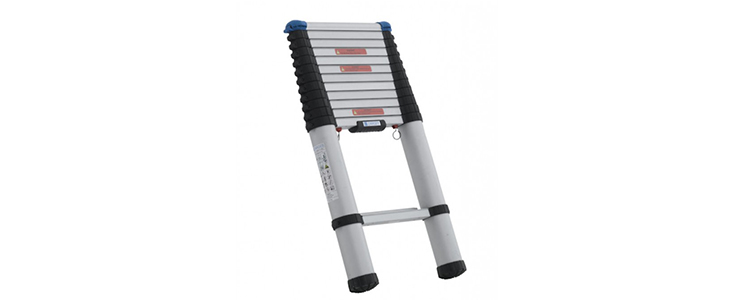We Answer Your Questions On Telescopic Ladders
07/08/2017
This week on the blog we’re continuing our series of FAQs on the various types of ladder we have available. Now it’s the turn of telescopic ladders – one of the latest innovations to hit the market, telescopic ladders can offer some distinctive benefits to homeowners and tradespeople alike.
Here are the questions we’ll cover in this blog:
- What is a telescopic ladder
- What are the advantages of telescopic ladders?
- What sort of jobs are telescopic ladders good for?
- How can I make sure I’m using one safely?
- How can I make sure I’m buying a quality telescopic ladder?
- What legislation affects telescopic ladders?
- What telescopic ladders would you recommend?
What is a telescopic ladder?

A telescopic ladder is more or less exactly what it sounds like; it’s an innovative design made up of several overlapping that enable the ladder to collapse into itself. Unlike rigid ladders, telescopic ladders are almost always made of aluminium, and can extend from a closed length of 0.8m all the way up to one of 3.3m. As you can imagine, this makes them useful in a variety of ways!
What are the benefits of telescopic ladders?
There are several advantages of telescopic ladders:
- Convenient storage – due to their compact nature
- Less vulnerable to the elements – partially due to storage, partially due to their makeup
- Lightweight – which means easy carrying and transportation
- Highly versatile – suitable for a number of jobs
- Excellent safety standards – due to sturdy build
What sort of jobs are telescopic ladders good for?
As we’ve mentioned just above, the versatile construction of telescopic ladders means they’re well suited for a number of jobs, especially those that would usually require the use of a rigid wooden ladder. For example, good jobs for a telescopic ladder might include roofing, painting or window cleaning. In fact, the fact that they’re made of aluminium means that they’re not vulnerable to the problems that some wooden ladders can suffer (such as rotting in damp conditions), making telescopic ladders even safer.
How can I make sure I’m using one safely?
Safety is as important with telescopic ladders as it is with any other ladder type. A lot of the safety aspects in telescopic ladders revolve around their safety-critical moving parts, especially their locking mechanisms.
Here are some easy ways to stay safe with telescopic ladders:
- Check the ladder’s stiles, rungs and feet, as you would with any other ladder
- Make sure that the mechanisms lock correctly in place before you start to climb
- Stabilise the ladder against a solid surface
- Ensure that the ladder is at the correct angle, and that the feet are braced properly against the floor (to avoid slipping)
- Try to avoid any sudden impacts when extending and closing it – these can weaken the safety mechanisms
- Don’t touch the locking mechanisms when you’re actually on the ladder
- Store your telescopic ladder in a clean and dry environment, to minimise the chance of rust or damage
How can I make sure I’m buying a quality telescopic ladder?
The very first – and probably obvious – step is to shop from a trusted, accredited retailer (say, for example, us!). Once you see the ladder in person, carry out your own ladder inspection before you use it for the first time. Remember, pay special attention to the locking mechanism.
If you’re particularly worried, you can look out for a sign that the telescopic ladder meets the standards of EN-131. This is not a legal requirement, but a voluntary standard that guarantees the safety, smooth function and reliability of the ladder. If you can see an indication that the ladder complies with EN-131, it’s a sure sign that you can trust it to do the job.
What legislation affects telescopic ladders?
As we’ve just touched upon, telescopic ladders are subject to the EN 131 European safety standard; this sets the minimum precedents in terms of its construction, the clarity of its instructions, its load-bearing weight and (amongst other things) its overall performance.
However – and this is important – it’s not a legal requirement. Like all UK ladder standards, it’s voluntary rather than mandatory. While it’s a reassuring bonus on any purchase, ladders without EN-131 verification are still capable of performing reliably and consistently, so it’s not necessarily something to be worried about.
What telescopic ladders would you recommend?
We’d recommend taking at least a quick look at our TB Davies Xtend+Climb telescopic ladder. It’s been manufactured to exacting specifications, and can promise stability, safety and quality in a single sturdy package.
If you think it might not be the one for you, however, don’t worry! We’ve got lots of other options available; click here to browse our range of telescopic ladders, or give us a call on 01282 615517, and we’ll be happy to help where we can.
Don’t forget to follow us on Twitter: @brownsladders